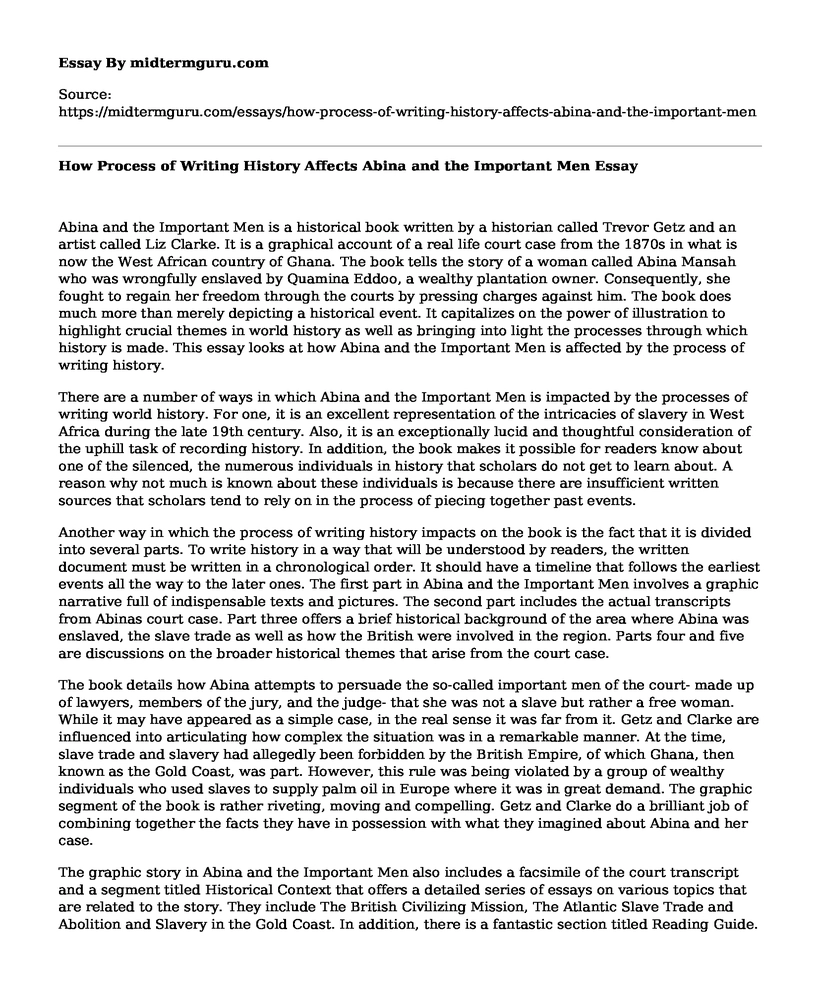Abina and the Important Men is a historical book written by a historian called Trevor Getz and an artist called Liz Clarke. It is a graphical account of a real life court case from the 1870s in what is now the West African country of Ghana. The book tells the story of a woman called Abina Mansah who was wrongfully enslaved by Quamina Eddoo, a wealthy plantation owner. Consequently, she fought to regain her freedom through the courts by pressing charges against him. The book does much more than merely depicting a historical event. It capitalizes on the power of illustration to highlight crucial themes in world history as well as bringing into light the processes through which history is made. This essay looks at how Abina and the Important Men is affected by the process of writing history.
There are a number of ways in which Abina and the Important Men is impacted by the processes of writing world history. For one, it is an excellent representation of the intricacies of slavery in West Africa during the late 19th century. Also, it is an exceptionally lucid and thoughtful consideration of the uphill task of recording history. In addition, the book makes it possible for readers know about one of the silenced, the numerous individuals in history that scholars do not get to learn about. A reason why not much is known about these individuals is because there are insufficient written sources that scholars tend to rely on in the process of piecing together past events.
Another way in which the process of writing history impacts on the book is the fact that it is divided into several parts. To write history in a way that will be understood by readers, the written document must be written in a chronological order. It should have a timeline that follows the earliest events all the way to the later ones. The first part in Abina and the Important Men involves a graphic narrative full of indispensable texts and pictures. The second part includes the actual transcripts from Abinas court case. Part three offers a brief historical background of the area where Abina was enslaved, the slave trade as well as how the British were involved in the region. Parts four and five are discussions on the broader historical themes that arise from the court case.
The book details how Abina attempts to persuade the so-called important men of the court- made up of lawyers, members of the jury, and the judge- that she was not a slave but rather a free woman. While it may have appeared as a simple case, in the real sense it was far from it. Getz and Clarke are influenced into articulating how complex the situation was in a remarkable manner. At the time, slave trade and slavery had allegedly been forbidden by the British Empire, of which Ghana, then known as the Gold Coast, was part. However, this rule was being violated by a group of wealthy individuals who used slaves to supply palm oil in Europe where it was in great demand. The graphic segment of the book is rather riveting, moving and compelling. Getz and Clarke do a brilliant job of combining together the facts they have in possession with what they imagined about Abina and her case.
The graphic story in Abina and the Important Men also includes a facsimile of the court transcript and a segment titled Historical Context that offers a detailed series of essays on various topics that are related to the story. They include The British Civilizing Mission, The Atlantic Slave Trade and Abolition and Slavery in the Gold Coast. In addition, there is a fantastic section titled Reading Guide. Getz unravels the numerous troublesome facets of putting into consideration the many aspects of the story. At the end of the book, there is a brilliant back matter that includes the introductory sketches by Clarke, playing the role of comic relief.
Abina and the Important Men is definitely influenced by how history is written, given that it is an exercise in the history reconstruction process. It builds on a concept known as Silences of History fronted by Michel-Rolph Trouillot, the great anthropologist. This is evident in the way Getz and Clarke try to give Abina a voice by filling in any empty gaps found in the court transcript. In the real sense, this transcript was a transliteration of what was actually said by Abina. Part four of the book explores the issues the authors were faced with while attempting to reconstruct Abinas voice. For instance, issues to do with how Abina looked like and talked, as well as decoding how significant it was to remove Abinas beads, were among the numerous issues that Getz and Clarke had to analyze and then re-interpret using their own creativity. Hence, it can be seen that Abina and the Important Men acts as a text for reinterpretation, just like the act of orally retelling an oral tradition.
Works Cited
Getz, Trevor and Liz Clarke. Abina and the Important Men: A Graphic History. Oxford University Press, USA. 2015. Print.
Cite this page
How Process of Writing History Affects Abina and the Important Men. (2021, May 24). Retrieved from https://midtermguru.com/essays/how-process-of-writing-history-affects-abina-and-the-important-men
If you are the original author of this essay and no longer wish to have it published on the midtermguru.com website, please click below to request its removal:
- Paper on History Example: World War I
- Essay Sample on Minority Oppression
- Gender Analysis of Chinua Achebe's "Things Fall Apart"
- Paper Example on Productivity and Growth 1820-1860
- Research Paper on Communication and Patient Behaviors
- Class or Race: What Matters Most in Society? - Research Paper
- The Role of Gender and Religion During the American Colonial Period - Essay Sample







